Car brand logos play a significant role in conveying the identity and values of the manufacturers behind them. These logos are not merely decorative; they encapsulate the essence of a brand’s history, purpose, and vision. The art of logo design involves a thoughtful process that goes beyond aesthetics, requiring creativity and insight to create symbols that resonate with consumers.
Renowned car logos, known for their distinctiveness, often carry meanings that reflect the brand’s heritage and aspirations. From iconic names like Toyota and Ferrari to the elegance of Mercedes-Benz and the performance spirit of BMW, the logos tell unique stories. Understanding these symbols provides valuable insights into what they represent within the automotive industry.
1- TOYOTA
The Toyota logo, created in 1990, is a sleek design composed of two interlocking ellipses inside a larger ellipse. This visual representation emphasizes the bond between the company and its customers. Additionally, the logo artfully embeds the letters T, O, Y, and A from the company’s name.
2- AUDI

The Audi brand has its origins with founder August Horch. After his departure from a previous car manufacturer, he launched Audi. This company later unified with four others to create a series of high-performance vehicles. The four rings in the Audi emblem symbolize the original manufacturers that combined to establish the modern Audi identity.
3- MERCEDES-BENZ

The Mercedes-Benz logo, featuring a three-pointed star, stands as a symbol of elegance and expertise. Each point represents air, water, and fire, while the surrounding ring reflects the brand’s authority in the automotive sector.
4- BMW

The BMW logo features a combination of blue and white colors, symbolizing an airplane propeller in motion. This design reflects the company’s roots in the aviation industry and is inspired by the previous logo of its founder’s earlier business.
5- MITSUBISHI MOTORS
Founded in 1914, Mitsubishi’s emblem consists of three diamonds arranged in a triangular form. This design signifies the company’s name in Japanese and honors the family names of its founders, Yamauchi and Iwasaki.
6- HYUNDAI
Hyundai’s emblem, often recognized as a stylized ‘H’, represents more than just a letter. It illustrates two individuals shaking hands, symbolizing the bond between the company and its customers. The logo’s blue hue conveys trustworthiness, while the silver tone reflects sophistication and excellence.
7- PORSCHE
The Porsche emblem combines elements from multiple national insignias. It features the Wuerttemberg coat of arms and a leaping horse, symbolizing speed. Created by the company’s founder during World War I while incarcerated, the logo signifies the brand’s legacy and dynamic performance.
8- CHEVROLET
The origins of the Chevrolet logo, characterized by its bow tie shape, have generated several intriguing theories. Some attribute its design to a pattern found on Parisian wallpaper, while others suggest that company founder Durant may have conceptualized it during a casual dinner. Additionally, there are claims that it was inspired by a newspaper advertisement viewed by Durant’s wife. The symbol may also reflect Durant’s Swedish background, resembling a traditional Swedish cross.
9- FERRARI
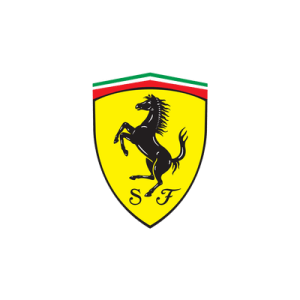
Ferrari is a prestigious Italian automobile manufacturer, distinguishable by its iconic logo, which features a prancing horse. This emblem pays tribute to Count Francesco Baracca, an esteemed World War I pilot, whose aircraft displayed a similar insignia. The choice of the horse is linked to Baracca’s cavalry background and his family’s heritage in equestrian activities.
10- LAMBORGHINI
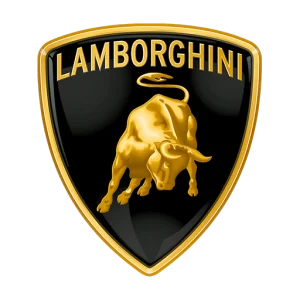
The Lamborghini logo features a fierce bull, representing the brand’s intensity and ambition to compete with leading automotive manufacturers. The striking yellow and black colors enhance the brand’s dynamic and spirited identity.
11- BENTLEY
Bentley’s emblem reflects elegance and luxury. The wings design conveys a sense of fluidity, while the prominent ‘B’ stands for the brand’s identity.
12- VOLKSWAGEN
Volkswagen translates to “People’s Car Factory” in German. The logo showcases the initials “VW,” which signify the brand’s heritage. Its design, resembling a ‘V’ formed by three fingers, reflects Volkswagen’s mission for shared success and commitment to its customers.
13- FORD
The Ford logo features a blue and white design inspired by Henry Ford’s affection for small creatures, particularly rabbits. Designers creatively represented this love with a pattern reminiscent of a small white rabbit.
14- ROLLS-ROYCE
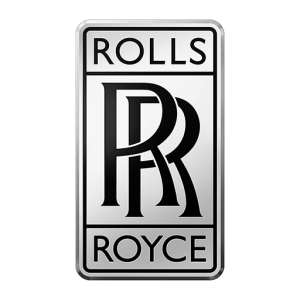
The emblem of Rolls-Royce features two interlocking ‘R’s, representing a commitment to partnership and unity. The distinctive trapezoidal logo is inspired by a statue of the goddess of victory housed in the Louvre, symbolizing grace and excellence. Designed by Charles Sykes, it captures a divine figure with an extended arm and flowing drapery, reflecting sophistication and prestige.
15- PEUGEOT
Peugeot’s emblem features a powerful lion, reflective of its origins as a 19th-century iron tool manufacturer. This lion embodies strength and signifies the company’s heritage in Franche-Comté, an area famed for its skilled craftsmanship.
16- ASTON MARTIN
The Aston Martin logo showcases the brand name flanked by elegant wings. This design reflects a commitment to speed and excellence, symbolizing both flight and high aspirations.
17 – LINCOLN
The logo of Lincoln is prominently displayed at the front of its vehicles, featuring an elongated star that conveys a sense of formality and importance. Established in 1907 by Henry Leland, this brand honors the legacy of the U.S. president, focusing on luxury automobiles.
18 – PANTHER
The name “Jaguar” has its roots in the SS Motor Company’s purchase of Sunbeam in 1937. Initially, the intent was to use “Sunbeam” as the brand name, but they chose “Jaguar” for its easy pronunciation and strong associations with agility and strength.
19- LEXUS
The Lexus emblem showcases the letter ‘L’, representing the brand’s dedication to luxury and quality. This design reflects its core values and identity.
20- Cadillac
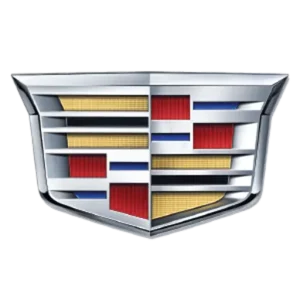
The Cadillac emblem features a crown and shield. This design honors Antoine Laumet de La Mothe, Sieur de Cadillac, the founder of Detroit. The crown signifies nobility, while the shield embodies the courageous essence linked to the brand’s identity.
21- CHRYSLER
Chrysler’s emblem features a five-pointed star, honoring its founder, Walter Chrysler. This star symbolizes the aspirations and ideals of both the Chrysler family and its workforce. Each point of the star illustrates the company’s global presence across all five continents, reflecting its enduring ambition and commitment to excellence in the automotive industry.
22- SUZUKI
The logo of Suzuki is characterized by the prominent letter ‘S’, representing the brand’s identity. This emblem signifies the company’s dedication to continuous advancement and the pursuit of innovation.
Car logos, including Suzuki’s, evoke various emotions, from enthusiasm to comfort. They serve as powerful symbols that embody a company’s core principles and are instantly recognized worldwide.
Throughout history, symbols have played a key role in expressing complex ideas. In the automotive sector, logos encapsulate the brand’s spirit, with each company delivering a unique message to its audience. From mainstream manufacturers to luxury automakers, these designs have become iconic, often holding stories that remain largely untold.
Shapes and Their Impact!
Geometric:
Geometric logos utilize fundamental shapes such as squares, circles, and triangles. These designs often convey a sense of stability and order, making them a popular choice for industries like finance and technology.
- Circles: These shapes often symbolize unity and motion. For example, BMW’s circular emblem represents innovation and quality through its blue and white design.
- Squares: Associated with reliability and professionalism, brands like Toyota employ squares to enhance consumer trust.
- Triangles: Triangles convey strength and directional progress. Mitsubishi’s logo, featuring three red shapes, illustrates both unity and power.
Organic:
Organic logos embrace natural shapes, like those found in flora and fauna. They are favored by brands aiming to project creativity and approachability.
Such designs often feature smooth, flowing lines. Luxury car brands such as Jaguar and Land Rover employ these shapes to suggest elegance and agility, particularly relevant for vehicles engineered to navigate difficult terrains.
Abstract:
Abstract logos strip down shapes to their basic forms to evoke feelings or concepts. These logos are prevalent in industries focused on creativity, such as advertising and art.
While appearing simplified, they can express complex ideas. For instance, Toyota’s logo, which consists of overlapping ellipses, symbolizes the bond between the brand and its customers. Similarly, Chevrolet’s distinctive bowtie design signifies a commitment to innovation and progress.
Summings-up:
These logos have become iconic representations of their manufacturers, significantly contributing to brand identity. They leave an enduring impact on enthusiasts and consumers alike, cementing their place in the automotive landscape.
FAQs Related to Blog
Why are logos essential for car manufacturers?
Logos are crucial for establishing brand identity and ensuring vehicles are quickly recognizable.
Do car logos convey hidden meanings?
Yes, many car logos include subtle symbols that reflect the brand’s values or heritage.
How do logos impact consumer views on brands?
Car logos can evoke specific emotions and associations, influencing perceptions of quality, reliability, and prestige.
Are automobile logos legally protected?
Yes, most car logos are trademarked to safeguard against unauthorized use, protecting the brand’s identity and reputation.


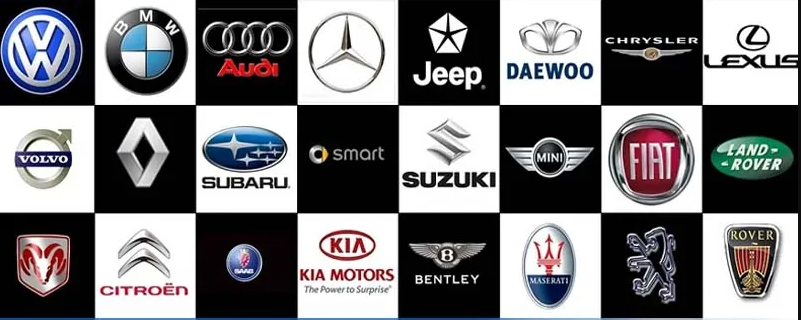
0 Comment